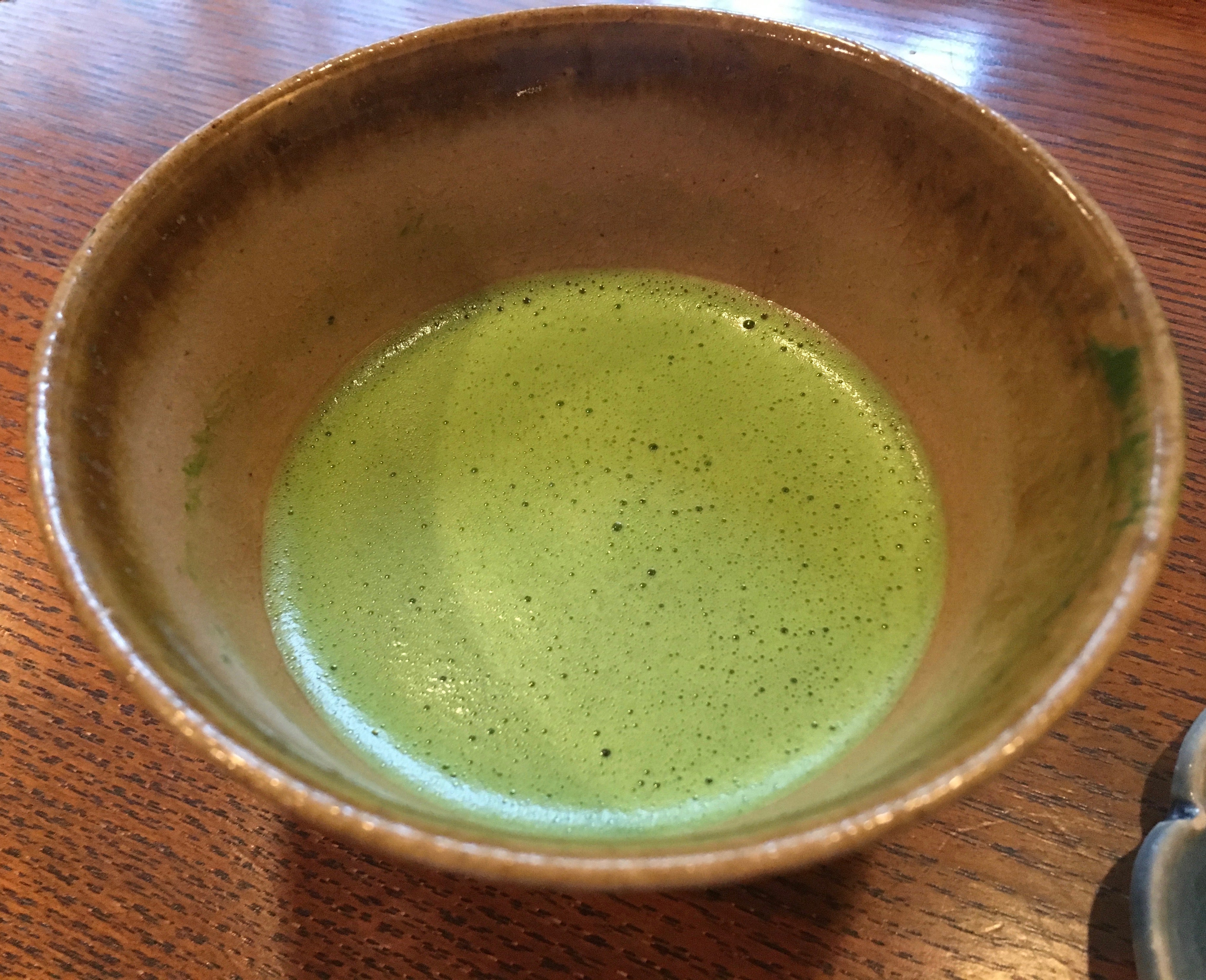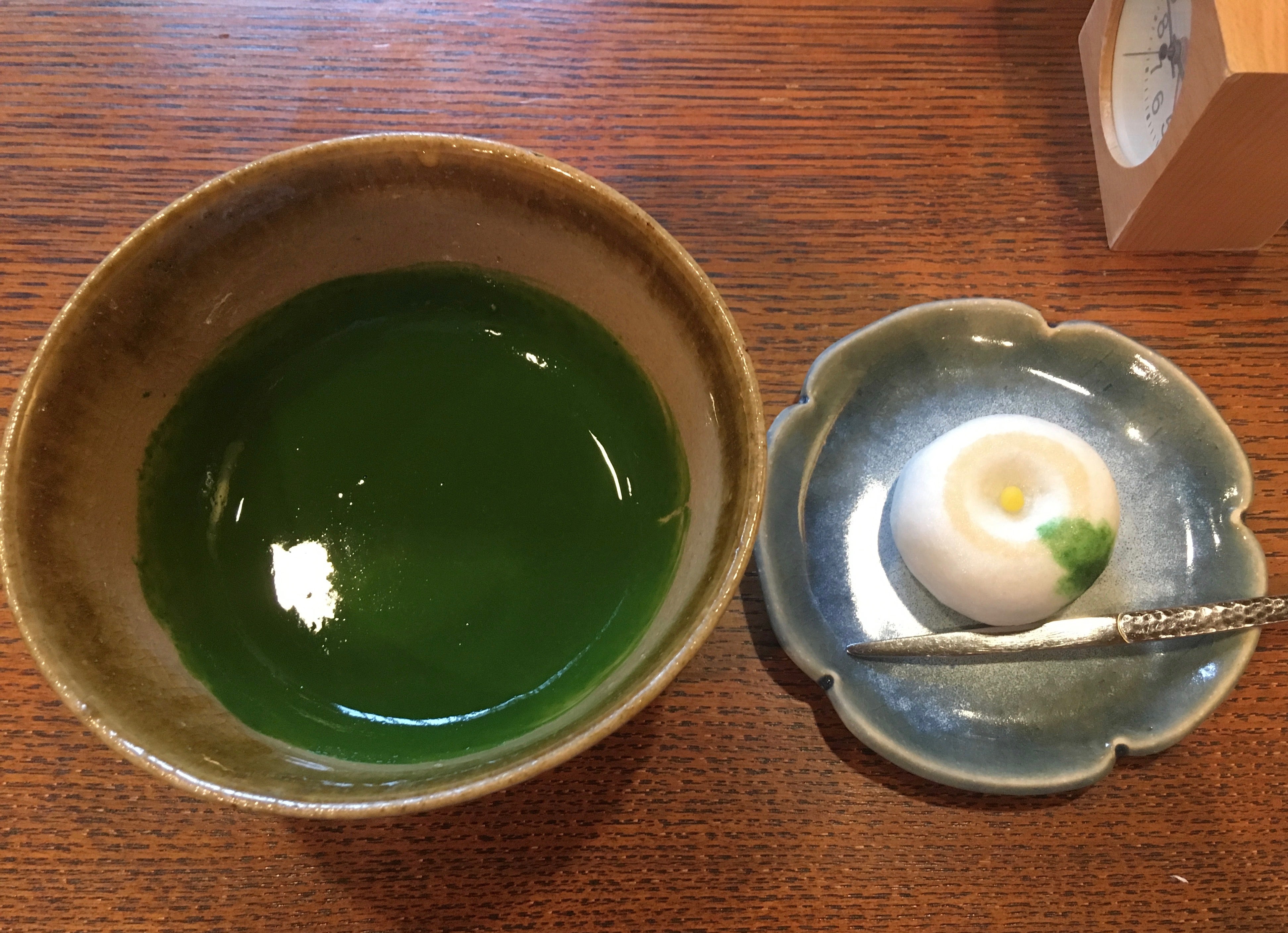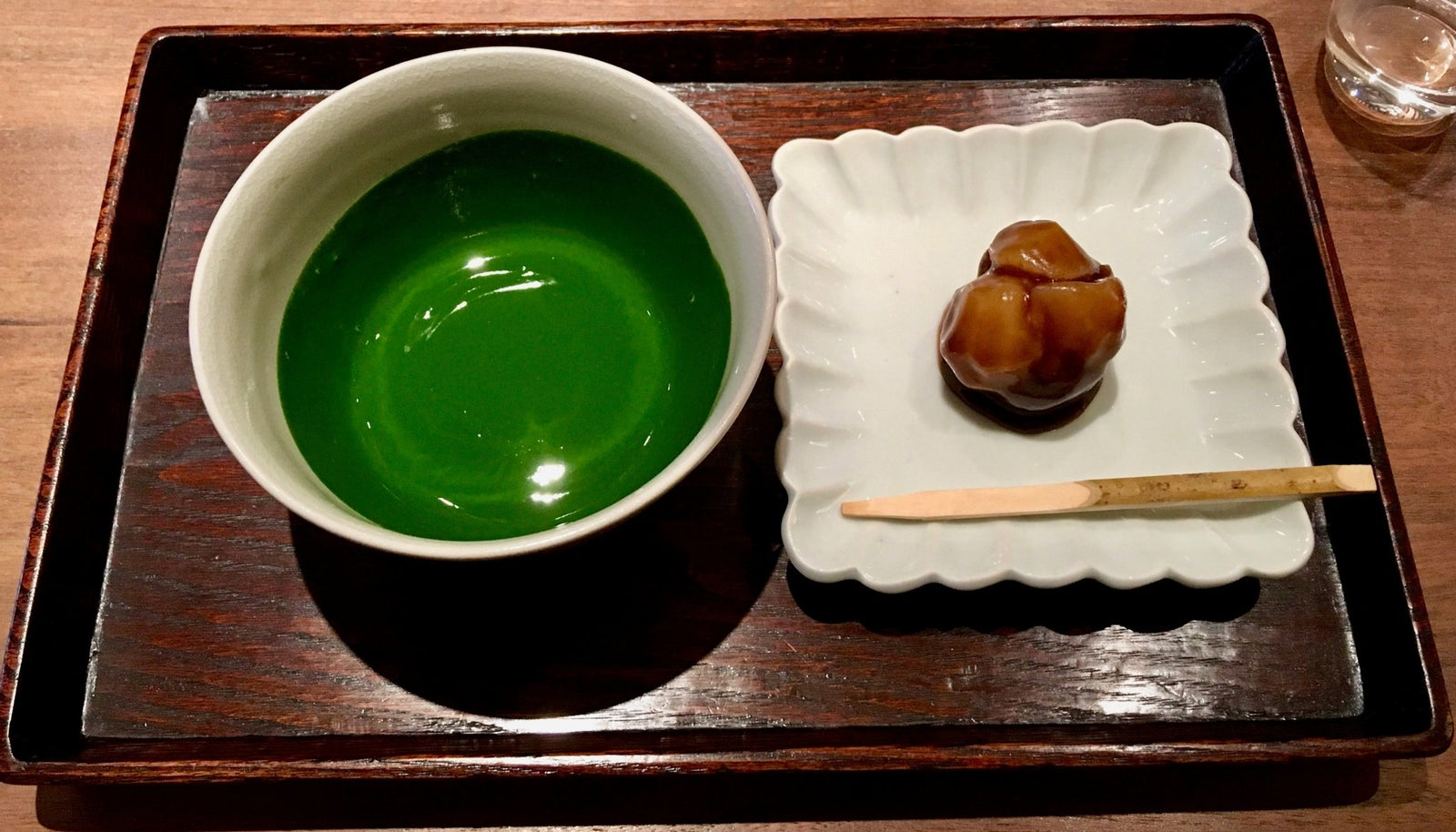抹茶には2種類の淹れ方があることをご存知ですか?薄茶と濃茶です。おそらく、皆さんがよくご存知の抹茶はこんな感じです。
 京都府の一保堂で提供される薄茶抹茶。写真はジミー・バーリッジ氏による。
京都府の一保堂で提供される薄茶抹茶。写真はジミー・バーリッジ氏による。
これは薄茶、つまり皆さんがよくご存知の一般的な種類です。日本のカフェでよく見かける薄茶は、家庭で淹れられたり、出されたりすることが多いです。日本語が少しでもわかる方なら、 「濃(こい)」と「薄(うす)」という文字は、抹茶の濃さを表しています。濃い抹茶は、抹茶と水の比率が高く、より香りと風味が豊かです。
まとめると、 抹茶は通常、収穫前に遮光され、蒸し、揉まずに乾燥させ(日本の緑茶のほとんどは揉みます)、フレーク状に精製され、その後細かい粉末に挽かれた高品質の茶葉です。遮光処理によって苦味のあるカテキンが減少し、代わりにうまみのあるテアニン含有量が増加し、抹茶独特の風味が生まれます。
厚い vs. 薄い
薄茶と濃茶の大きな違いは、その濃さです。薄茶抹茶を飲んだことがある方もいらっしゃるかもしれませんが(お茶のように滑らかですよね?)、濃茶を飲んだことがない方は、濃茶の濃さに驚くかもしれません!実際、濃茶はまるで濃いスープのような、シロップのような濃さです!この濃さは、薄茶に比べて抹茶の量が2~3倍、水の量が少なめだからです。私も初めて濃茶を飲んだ時、見た目だけで「渋い」(日本語で「苦い」という意味)だろうと思いました。
 京都府の一保堂で提供される濃茶抹茶。写真はジミー・バーリッジ氏による。
京都府の一保堂で提供される濃茶抹茶。写真はジミー・バーリッジ氏による。
しかし、風味に関して言えば、濃茶に使われる抹茶は一般的に旨味と甘味が強く、苦味は控えめです。そのため、私にとっては、特に和菓子がお茶の強さをうまく和らげてくれたので、かなり濃厚でありながら心地よい体験となりました。
もう少し詳しく説明すると、まるで苔むした緑の夢のような、奥深い世界へと誘われたかのようでした。未知の世界でありながら、不思議なほど馴染みのある魔法の世界に。鮮やかな緑の生命、柔らかくくぐもった音、そして濃厚で湿った空気が重なり合う、宮崎駿監督の映画『もののけ姫』のワンシーンを彷彿とさせるような感覚でした。

青森県奥入瀬の苔むした仲間たち。写真は岸田萌さん。
濃茶には昔風の抹茶パウダーを選びましょう
濃茶に使われる抹茶は甘く、品質も高く、価格も高くなります。日本では、濃茶に合う抹茶を探すときは、一般的に「昔」の文字で探します。一方、薄茶用の抹茶を探す場合は、「白」の文字で探します。もちろん、茶葉販売店の人に尋ねてみるのも良いでしょう。少なくとも日本では、そして海外でも、ある程度の高級な茶葉販売店であれば、濃茶と薄茶の違いを理解しているので、きっと説明してくれるはずです。
Yunomiのサイトでもこの方法を試すことができます! 「mukashi」で検索すると、濃茶に適した抹茶が見つかります。「koicha」だけで検索することも可能です。抹茶パウダーの説明欄に、濃茶に適しているかどうかが記載されています。
 松玉園製茶工場の抹茶2種類 (京都府京鍋町)濃い茶の場合は左側の「昔」 、薄茶の場合は右側の「白」の文字に注目してください。商品写真はYunomiより提供。
松玉園製茶工場の抹茶2種類 (京都府京鍋町)濃い茶の場合は左側の「昔」 、薄茶の場合は右側の「白」の文字に注目してください。商品写真はYunomiより提供。
湯呑みから濃茶を作るのに適した抹茶の例:
- AOI製茶:西尾抹茶 孫光の昔皇室典礼級濃茶(30g 4900円)
- AOI製茶:西尾抹茶 天渓 儀式遺産級濃茶(30g 10,000円)
- 西出製茶所:宇治抹茶 千代昔 石臼挽き 標準式上等(40g、2300円)
- 松玉園製茶所 抹茶初昔皇室御用級 春摘み初昔(40g 3499円)
このリストは網羅的なものではありませんが、これらの抹茶はYunomiで販売されている他の抹茶と比べて少し高価であることがわかります。一般的に、日本では濃茶に適した抹茶は40グラムで少なくとも2,000円(約18ドル)かかります。抹茶の品質に関する詳細は、イアン・チュンの記事「Yunomi Matcha Grades(Yunomi抹茶のグレード)」をご覧ください。
濃茶を練る(泡立てない!)
前述の通り、濃茶を淹れるには薄茶の約2倍の量の抹茶を使います。茶葉と水の量は茶道の流派によって異なりますが、一般的には薄茶には抹茶2g、濃茶には抹茶4gを使用します。濃茶は、約80℃(176℉)のお湯に約40mlのお湯を加え、混ぜる動作は「抹茶を“ねる”」(抹茶を練る)と呼ばれます。 「練る」と「泡立てる」の違いは微妙に思えるかもしれません。正しい方法を習得するには何年もかかることもありますが、直感的に理解できる場合もあります。
濃茶の写真からもわかるように、濃い抹茶には泡が立ちません。もし茶道の先生が見ていない時に、もしご自身で試してみたい場合は、泡を立てずに、抹茶と水の層を優しくこねて上下の層を反転させてみてください。パン作りに慣れている方は、グルテンを壊さないよう生地を折りたたむ工程を思い出してください。しっかりとこねることで、濃厚で滑らかな、シロップのような抹茶が出来上がります。
これは、約90℃(華氏194度)のお湯約60mlを使用する薄茶の淹れ方とは対照的です。薄茶抹茶を点てる動作は、 「抹茶を点てる」(抹茶を点てる)と呼ばれます。この点てる動作の目的は、細かい泡を厚く立てることですが、もちろん抹茶の種類によって泡の出具合は異なり、泡の量だけで品質や技術を判断することはできません。
厚みと品質を超えて
最後に、抹茶碗の使い方や抹茶の楽しみ方にも違いがあります。薄茶では、季節に合った茶碗を選びます。ご存知の通り、季節感を表現することは、装飾や料理、器の組み合わせ、そして会話の中にもさりげない工夫が凝らされた日本の高度な文化です。薄茶碗は美しく、色鮮やかなデザインが施されていることが多く、実際、薄茶会では、茶碗にまつわる会話を楽しむことも習慣となっています。そのため、様々な柄、色、デザインから自由に選ぶことができます。薄茶会では、複数の客がいる場合は、一人につき一碗の抹茶が振る舞われます。
一方、濃茶を楽しむには、茶道で最も格式高い陶器のひとつである楽焼で作られた茶碗を使います。このタイプの茶碗の特徴は、シンプルで模様がないことです。知識のある人なら、特定の密度の粘土と厳選された釉薬で作られていることがわかります。これらは「手捏ね」と呼ばれる方法で作られ、ろくろを使わずに手とヘラだけで作られています。より正式な楽焼の茶碗は、偉大な茶人である千利休の侘びの趣味を反映しています。最後に、濃茶の儀式では、1杯の濃茶をすべてのゲスト(たとえば、3〜5人のゲスト)で楽しみます。抹茶のこの楽しみ方は、千利休の時代に確立されたと言われています。
濃茶と薄茶の主なポイント
 *これらは明確な違いであることに注意してください。ただし、日本の茶道を研究すると、実際の茶道には他にも多数の細かい違いがあることがわかります (たとえば、その他の違いの詳細な表はこちらです)。
*これらは明確な違いであることに注意してください。ただし、日本の茶道を研究すると、実際の茶道には他にも多数の細かい違いがあることがわかります (たとえば、その他の違いの詳細な表はこちらです)。
濃茶を試してみませんか?誰もが楽しめるものではないかもしれませんが、抹茶好きの方なら一度は体験していただきたい、特別な体験です。まあ、これはあくまで私の個人的な意見ですが!薄茶と濃茶はそれぞれがおもてなしの心を表すものですが、正式な儀式では薄茶の後に濃茶を点てることもあります。この正式な儀式では、この二つの抹茶は互いに補完し合い、陰と陽、太陽と月、秋と春のように調和するのです。
特集イメージ写真:東京・一保堂で提供される濃茶抹茶。撮影:ジミー・バーリッジ



1件のコメント
I practice tea ceremony and Koicha to me is the essence of the tea ceremony.